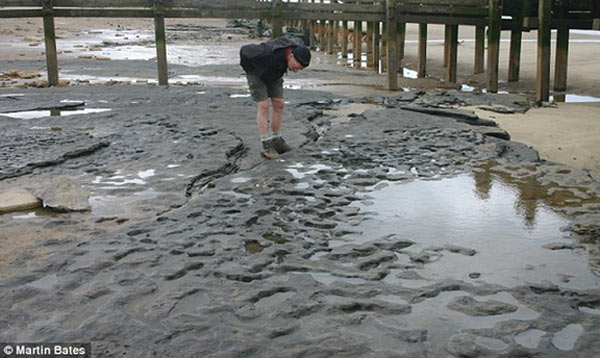Oldest human footprints outside Africa discovered in England
Archaeologists have just announced the discovery of the earliest footprints left by humans outside Africa in estuary mud in England, in a finding that has been described as ‘the most important discovery on British shores’. The ancient human footprints are direct evidence of the earliest known humans in Europe.
In a chance encounter which has been described as a “million to one” discovery, the footprints were only found after being exposed by low sea tides when heavy waves washed away much of the beach sand. Scientists rushed to take photographs and moulds of them before they disappeared once again.
"We found them by pure chance in May last year," writes Nicholas Ashton, a curator at the British Museum in London. "We knew the sediments at Happisburgh were over 800,000 years old," says Ashton. So if the hollows turned out to be footprints, they would be older than anything outside of the cradle of humanity, Africa.
According to the research report, published yesterday in the journal PLOS ONE, the prints were probably made by five different people, both adults and children, and show distinct heel, arch and toe marks. Using 3D computer reconstruction, the researchers were even able to estimate the height and weight of the owners. Heights among the group topped out at about 5.6 feet.

Scientists created this model of the footprints using photgrammetric survey data. Photo credit.
"We actually know very little else about the people who left these prints," Ashton says. However, height estimates lead scientists to believe that the prints may have been made by a 1.2 million-year-old species known as Homo antecessor. Only three other sets of footprints, discovered in Africa, are more ancient than these ones.
The footprints might help scientists understand how some of our early human predecessors made their way in the ancient world. Christ Stringer, Natural History Museum archaeologists, said that 800,000 to 900,000 years ago Britain was at “the edge of the inhabited world”. He added, “this makes us rethink our feelings about the capacity of these early people”.
Dr Martin Bates, a geoarchaeologists from the University of Wales, describes what the discovery meant to him:
“Standing there looking at the footprints really brought the intimacy of who these human ancestors were to me. As a geoarchaeologist I tend to get divorced from the human side of archaeology sometimes. With a footprint you can see what they were doing and look in the direction they were looking. I was confronting these individuals as humans.”
Watch a video of the operation to record the prints before they became lost once again.
Featured image: An archaeologist examining the exposed footprints. Photo credit: Martin Bates.




















Comments
What an evocative find!
Fascinating and nice that something good has come out of the storms and floods.
Sculptures, carvings & artwork inspired by a love of history & nature: www.justbod.co.uk
A woman did her thesis on the differences of foot bones in various "tribes" of Briton. It was called "Foot Loose in Great Britain". She actually found that one could distinguish between Anglo and Saxon skeletons by the bones of the foot! I wonder if that information could be applied to these casts?